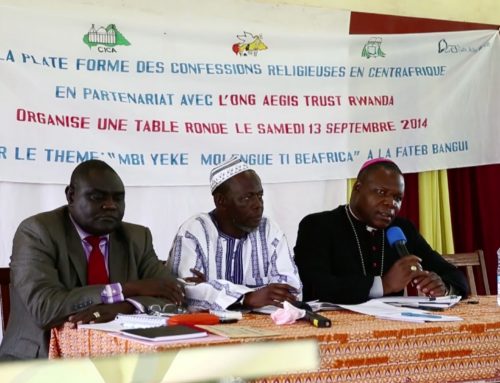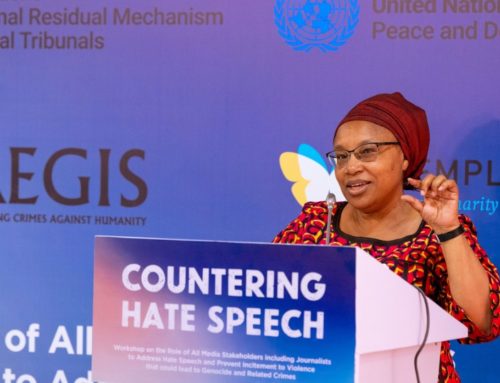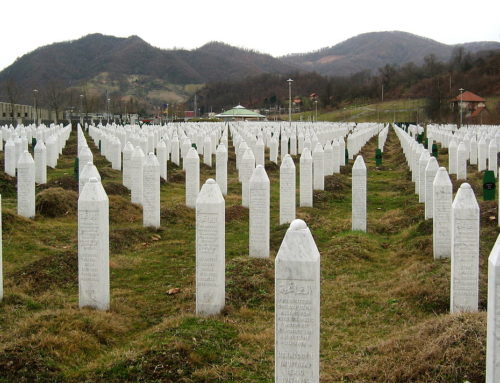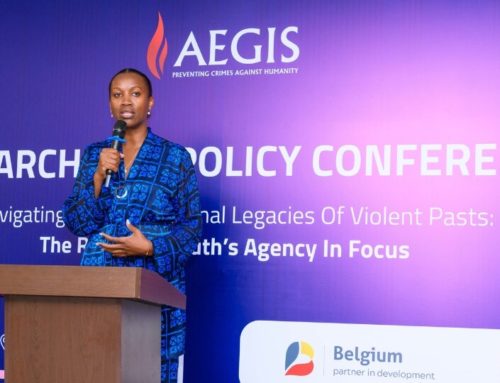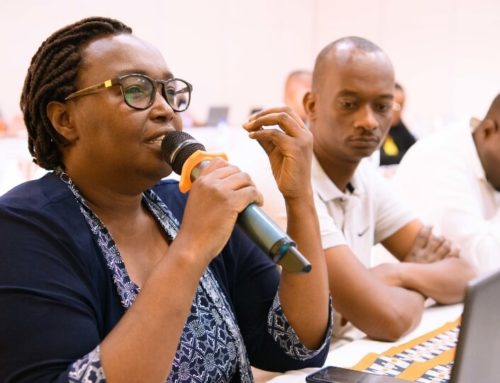20 April 2006, House of Commons
It gives me great pleasure to welcome you all to this lunch today which aims to highlight the challenging and ground-breaking work undertaken by the Aegis Trust, both here in the UK and in Africa.
As I am sure many of you are already aware, Aegis is a genocide prevention charity. The word ‘Aegis’ itself means ‘shield’ or ‘protection’ and the Trust was established in 2000 to work on prevention strategies in situations of potential genocide. But Aegis works not only to stop crimes against humanity before they happen, but also to help people deal with the consequences of genocide long after the killing has stopped. Aegis works alongside its sister organisation, The Holocaust Centre, sharing the vision that people of all backgrounds need to learn from the Holocaust that genocide must become a thing of the past.
But the task is a very demanding one. How do you prevent genocide? Mass killing, ethnic cleansing, state-sponsored crimes and genocide have been an ever-emerging trait of human behaviour and a blight on human history. We now know that genocide does not happen by chance. It is cold, calculated and takes time to emerge. It is therefore preventable, but the difficult issue is how to understand and interpret the warning signs with sufficient clarity and then act in a decisive way.
In our own recent history, only 12 years ago, many of you probably remember the devastating reports from Rwanda in 1994. In the space of 100 days of horrendous violence, one million Tutsis and moderate Hutus lost their lives in a vicious genocide that has scarred the conscience of the world. Broadcasts about bloodshed in Rwanda took weeks to catch our attention – it was portrayed as yet another African civil war. Without the familiar symbols of cattle trucks and barbed wire, we did not understand that genocide was taking place – and meanwhile one million people were murdered, largely by machete, drowning, shooting and with grenades thrown into crowded, locked buildings. The international community acted too late to prevent or stop the genocide, and in so doing must share part of the responsibility for this tragedy.
Personally, I was to learn first-hand about the 1994 genocide when I visited the Kigali Memorial Centre in July 2005 with America’s First Lady, Laura Bush. That was also when I first became aware of the immense input that Aegis was making in Rwanda in the aftermath of the genocide. When I visited the Centre, saw the exhibition and read some of the powerful testimonies, I felt humbled by the dignity of the survivors in the face of such appalling experiences. And I also felt great admiration for the enormous challenges Aegis had undertaken to help and support survivors, to give them back some dignity.
I was at first surprised to learn that a UK-based charity, the Aegis Trust, was responsible for the creation and administration of the Kigali Memorial Centre. But on reflection, I realised that experience in establishing the UK’s Holocaust Centre gave the Aegis Trust’s directors the best possible background and experience for the task. Kigali Memorial Centre was built on a site where over 250,000 genocide victims are buried. It opened in April 2004 on the 10th anniversary of the genocide and is a permanent memorial to those who fell victim to the genocide. It is a place for people to grieve for those they lost. It is a memorial and site for commemoration. And it is a place of education and learning for visitors from Rwanda and abroad.
The Centre’s role is in fact threefold: it aims to give dignity to survivors; to provide education about genocide, mainly for young people; and to preserve documentation and information relating to the genocide. The Centre in Rwanda provides a compelling message for international visitors about what happens when we fail to fulfil our responsibility to protect those under threat of genocide – a story told most powerfully in the recently released BBC film, Shooting Dogs.
One of the key challenges Aegis faces in Rwanda is the development of education programmes at the Centre that will enable a generation of young Rwandans to understand how the genocide happened and, as a result, to take personal responsibility for preventing it from happening again.
But the work of Aegis expands far beyond this. It supports the work of restorative justice by acknowledging the events that took place in 1994 and promoting trust between ethnic groups. And it works constantly to reduce the risks of recurring violence through its formal and informal education programmes about the genocide.
Aegis recognises the importance of documentation of the genocide. For the sake of future generations, it is essential that the story is told as fully as possible. Survivors’ experiences need to be acknowledged. They provide a dignified memory for those who perished. Children need to understand what happened and learn about individual responsibility. All of this is key to developing communities free from fear and mistrust. And the primary information gathered will clearly enhance future research into how genocide occurs.
That is why the Kigali Documentation Centre houses a research library, an archive, an audio-visual testimony archive and a GPS mapping project. To date, the Aegis data acquisition team has interviewed 2,573 people in Rwanda, identified 4,522 families in which members were victims, identified the names of 17,970 victims and the sites of 466 mass graves (each commonly estimated to contain 20-30 bodies). They have also collected 1,261 photos from the families of victims, which are being scanned to create a photo archive.
Aegis also recognises the paramount importance of restorative justice in Rwanda, and particularly through the Gacaca trials which are currently taking place. Based on the traditional local court system, Gacaca literally means ‘justice on the grass’. These trials are the Rwandan Government’s innovative means of delivering justice in a society where mass murder has been committed. Aegis is creating a visual record of the proceedings of these uniquely significant village courts, where perpetrators of genocide are tried and cross-examined by the very communities in which they committed their crimes. These film archives are housed at the National Genocide Documentation Centre as part of the Kigali Memorial Centre. The documentation of this process will provide invaluable material for research into justice processes and new insights into perpetrator mentality that can inform future preventative strategies.
In post-genocidal and conflict situations, this restorative justice is crucial. It means involving the perpetrators and victims in the justice process – to remember the atrocities committed, encourage repentance from the perpetrators and enable forgiveness from victims. It has had a part to play in bringing about reconciliation and understanding in a number of different scenarios, from South Africa to Columbia, often working alongside national criminal justice systems and international war crimes tribunals.
I myself was privileged to visit a Gacaca court in Rwanda and to observe this process in action. For someone brought up in the UK’s court system, it was an unforgettable experience – and made me reflect on the huge difficulties of Rwanda’s post-genocide situation, with over 100,000 genocide suspects behind bars. Clearly, it would be impossible to imprison so many killers for life. But while some of those found guilty may serve time in prison, for the majority, Gacaca effectively marks the start of a process of rehabilitation into the community. The process is continued through ‘solidarity camps’, in which genocide convicts who have already served the minimum sentence are given lessons in citizenship.
This justice process obviously places demands on survivors that are unprecedented in the history of genocide. And we should not forget that while outsiders come in talking about Rwanda’s need to engage in reconciliation, the survivors have to get on with sharing their neighbourhoods, streets and churches with those who killed their families. Rebuilding a nation after its fabric has been torn apart requires extraordinary efforts on all sides.
But Aegis is not content simply with a documentary role in this justice process. It is also involved in active campaigning, as for instance in the recent legal case of Charles Munyaneza case.
Munyaneza, a former government official, is a suspected perpetrator in the Rwandan genocide. He is accused of helping to carry out the mass murder of thousands of civilians and is alleged to have urged people to massacre Tutsis. According to African Rights, he said at one point: “All of you, men, women and girls, must take part. I don’t want to see a single Tutsi alive on this hill.” Munyaneza settled under a false name in Britain, having been granted indefinite leave to remain as an asylum seeker.
It is a challenging legal case for the UK. Because Rwanda has not ruled out seeking the death penalty for those convicted of carrying out the 1994 genocide, extradition from the UK could prove problematic. At present, apart from crimes committed during the Nazi era, British courts do not have jurisdiction to hear cases involving genocidal crimes committed on foreign soil. Legislation does exist for the sanctioning of carrying out torture, but not for committing genocide on foreign soil. Aegis is working with parliamentarians and lawyers towards filling this gap in UK domestic law.
This campaigning aspect of Aegis’ work is also much in evidence in connection with the situation in Darfur, Western Sudan. The conflict in Darfur has raged now for over three years. It is estimated that between 180,000 and 400,000 people have died as a result of violence, disease and hunger. A campaign of ethnic cleansing has led to 2 million people fleeing from their homes, most of whom are now located in camps located in Darfur and across the border in Chad. Many of these refugees have been forced to relocate many times due to continued violence. Most have been living in these camps for over a year if not two. At present there is little prospect of them being able to return to their homes so as to rebuild their lives.
It is during times of crisis like this that Aegis acts to ensure that issues of such importance are raised up the political agenda. Accordingly, the Trust is actively involved in lobbying to push governments and international organisations like the United Nations to take effective action to end the violence in Darfur. The ‘Protect Darfur’campaign is an example of crisis campaigning in which a combination of expert reports, a website, news items, parliamentary alliances and non-governmental cooperation have successfully raised a significant public profile. The aim was clear: to generate media and political attention, demanding robust action to stop the murder, rape and displacement of the men, women and children of Darfur.
Aegis, for instance, was one of the first organisations to call for a Security Council referral to the International Criminal Court – the first such referral of alleged crimes against humanity to the ICC, a significant landmark in international justice. Aegis is also challenging Home Office policy on internal flight – the principle that it is safe for Darfuri Africans to flee to another area of Sudan – and will publish a report on the subject next week. And it is actively involved in documentation work which will add to the accountability process.
Everybody says ‘Never Again’ after the Holocaust, Srebrenica and Rwanda. But it keeps happening again and again. Aegis knows that crimes against humanity have continued for too long, in too many places, over the last 60 years. It does not stand by and observe events. It takes vigorous action to prevent and stop these abuses. It helps and supports victims. It campaigns to build a better future. And I am sure you will all agree that Aegis deserves our fullest support.

